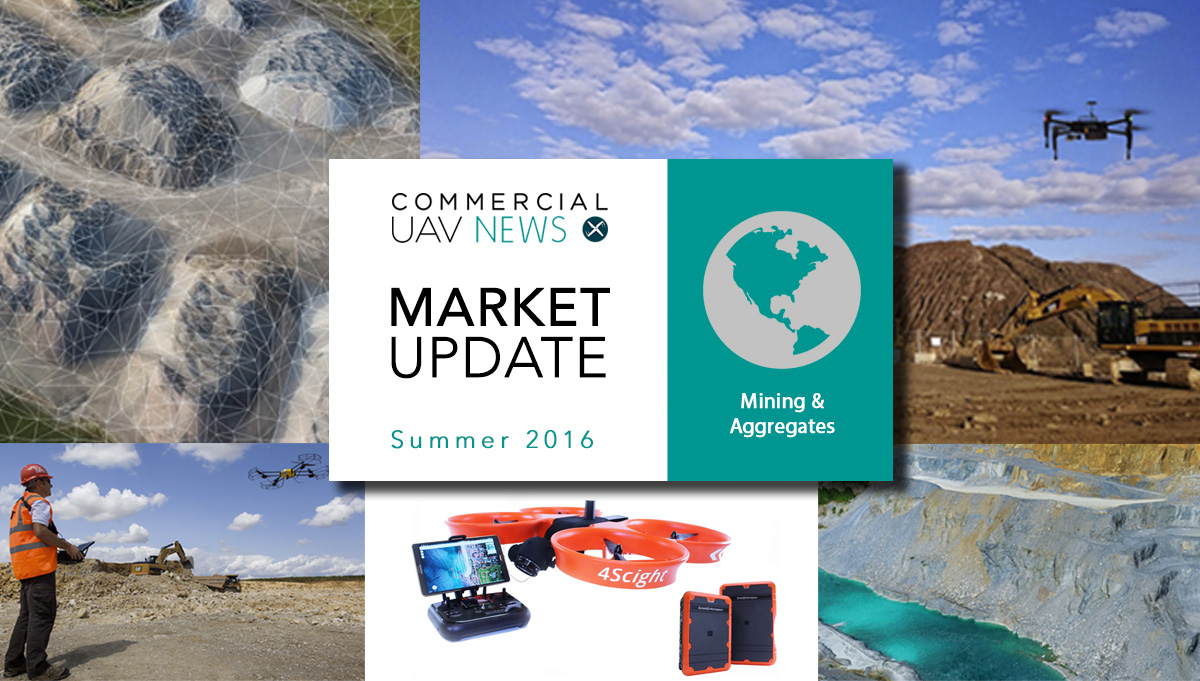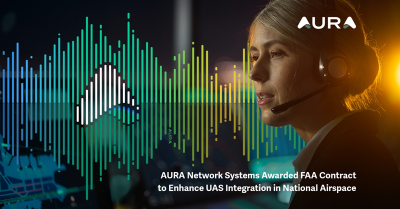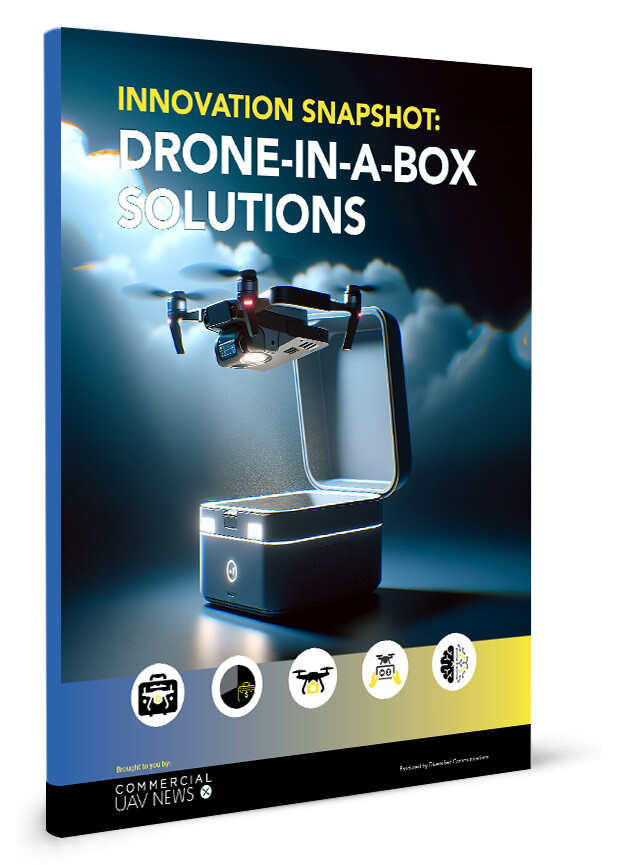
Mining & Aggregates
The mining industry in South Africa is one of the areas where the use of drones has considerably increased. That’s one of the highlights of this report, which also indicates how the industry is rapidly adapting after FAA released
Part 107 of the Federal Aviation Regulations. With companies such as DJI entering the mining industry with their drones, there is a growing understanding around how many tasks drones can be used to perform, which range from surveillance to more accurate stockpile measurement processes. Plus, the impact UAVs can have on safety and the bottom line can be
even more significant. We’re still taking baby steps into what is a huge market expanding with a multiplicity of options.
We’ve covered different aspects of that progression here at Commercial UAV News, in articles such as “
Identifying a Need for Drones in Stockpile Volumetric Measurement” and “
Increasing Accuracy, Affordability, Safety and Speed”, but the flow of news never ends and the digest presented here proves that. The mining industry is reshaping itself with the introduction of drones for multiple activities, and that process will be playing itself out in a major way over the next few months and years under Part 107.
 Caterpillar UK offers new drone service
Caterpillar UK offers new drone serviceCaterpillar and Redbird, a drone analytics firm based in Paris and San Francisco, formed a partnership in December 2015 to offer Caterpillar customers in the UK access to data gathered by drones. The company “aims to provide customers with a variety of solutions for their operations,” according to the demonstration manager Phil Lewis, from UK Caterpillar dealer Finning.
Emmanuel de Maistre, chief executive at Redbird said: “We are now at the point where we can launch this to the market and help UK business realize the benefits of the solutions we have been developing with leading construction companies and quarry operators for the past two years. We are all about helping businesses extract the real value out of drone data and by bringing tangible benefits to construction sites, mines and quarries across the UK, we will be looking to help customers work faster and safer.” Follow the
link to read the whole story.  A drone designed for surveying
A drone designed for surveyingWhile multiple companies, from BHP to Rio Tinto, have integrated drones on to their sites, as mining becomes more automated and surveying from the sky becomes a faster and safer manner of collecting data, an Australian partnership has been formed to taking this mapping technology to the next level.
West Australian drone manufacturer ScientificAerospace has partnered with South Australian mapping company Dronemetrex to develop a new drone specially designed to aid surveyors. The
TopoDrone-4Scight is a vertical take-off and landing drone with ducted fans for extra safety and a more stable flight. It can also be used in spark free safety conscious applications, due to its non-conductive airframe and brushless motors. Read the whole story by following the
link to Australian Mining.  Drones in mining and regulated airspace
Drones in mining and regulated airspaceThe use of drones as a low-cost replacement for traditional helicopters is on the rise in today’s mining industry. Mining companies are seeing benefits from the use of drones from safety and security to exploration and development. The article “The Impact of the Federal Aviation Administration’s Final Drone Rule on the Mining Industry” covers different aspects related to the use of drones in mining operations within areas of regulated and unregulated airspace or subject to special conditions (i.e. airports, military training areas).
The article indicates that “most of the final rules can be waived with the FAA’s permission if a drone operator can demonstrate that flying a drone without observing a particular rule will not pose a safety risk” but adds that the FAA’s waiving of its regulations does not preclude Mine Safety and Health Administration (MSHA) from enforcing its regulations related to things such as accident reporting and pre-operational checks on mobile equipment. Follow the link to
read the whole article.  DJI drones enter mining industry
DJI drones enter mining industryDJI and Propeller Aero Bring entered a partnership to propose turnkey solutions to construction and mining industries. The partnership integrates DJI’s commercial-grade aerial platform, the Matrice 100, with Propeller’s cloud-based software specifically designed for surveying and inspection. This easy-to-use, fully-integrated solution will provide enterprises and commercial UAV operators a simplified, quick and efficient way to automate operations and access data.
The Matrice 100 platform has all of DJI’s easy-to-fly technology built in, including the flight controller, propulsion system, GPS, DJI Lightbridge, a dedicated remote controller, and a rechargeable battery. Propeller Aero’s online platform offers industry-leading capabilities for geospatial data processing, analytics and collaboration, including instant volumetric calculations and the ability to track changes over time. It has seen rapid adoption by commercial drone operators and enterprise clients in over 60 countries,
says DJI.
Stockpile monitoring drones
The owner of one of the biggest quarry sites worldwide, Groupe CB, has introduced drones for stockpile monitoring at their sites. Traditional stockpile measuring processes took five days to complete, a time-consuming, inaccurate and expensive process. Drone-based volume measurement allows for, substantially, lower cost, faster and more accurate information in just a few clicks.
Groupe CB has taken that new approach in collecting volumetric data for stockpiles. By using a drone, digital imagery is gathered to be processed into a highly accurate 3D model of the site. “Drone data processing is a technology that quarries all over the world will come to adopt, because it is so simple and reliable. I am convinced that in the near future, quarry monitoring will be done exclusively with drones.” says Vincent Amossé, Deputy CEO from Groupe CB.
Follow the link to read the article “
Drones and Cloud Technology for Stockpile Monitoring”.
 Drones in mining: fastest growth in South Africa
Drones in mining: fastest growth in South AfricaWith some drones flying illegally, the fastest growth observed in South Africa when it comes to drones is in the mining industry. In fact, according to the article published by iTWeb, “SA mining companies are turning to drone or UAV technology to revamp their operations and rethink their cost structures. The mining industry has become the latest industry to embrace drones, which are used for everything ranging from mapping to mineral exploration to tracking stockpiles.”
According to Adrian Schofield, ICT veteran and director and vice president of the Institute of Information Technology Professionals South Africa (IITPSA), “in mining, drones are used mainly for photography, videography and delivery of payloads”. To fly drones commercially in SA it is necessary to have a license and a remote operator certificate (ROC) which is an operations certificate, obtained only after having an Air Service License from the department of transport. The cost and difficulty of the process has led some operators to fly illegally. Read the
whole article following the link.
 Hiring a professional drone service provider
Hiring a professional drone service providerWhile more and more companies in mining and other industries are planning to incorporate drone-based aerial surveys into their operations, many continue to wrestle with one question: whether to hire third-party drone service providers to perform aerial surveys or whether to bring drone operations in-house.
Since the idea of having in house drone operations suggests a significant investment, some companies have discovered that it's better to hire drone service providers. However, when doing so it's essential to make sure that whoever the company hires can offer the services they need. That’s what this case-study published by Anya Lamb, Marketing Manager at DroneDeploy, reflects about. Read the
whole story following the link.
 Drones to watch quarry explosions
Drones to watch quarry explosionsAt Mitchells Quarry, located in Culpeper County, drones are used to fly above the 50-acre quarry to monitor as explosives blast away large chunks of granite. During a recent visit by U.S. Senator Mark Warner, D-Virginia, a proponent of unmanned aerial vehicles, a demonstration of the process was prepared. “We use drones for about every other blast to understand if we’re using the right amount of explosives,” Cedar Mountain Stone Corp. owner Ed Dalrymple told the
Culpeper Star-Exponent.“Before the recent advent of drones, the quarry gauged its use of explosives by eye. We stood back and watched it and said, ‘hey this looks pretty good,’ ” Dalrymple said. “This way we get to see the physical effect.” The article continues with more information about the use of drones in the region, including info on a drone training program for commercial applications.
The roles of drones in the industryAccording to an article in North American Quarry News, “Drones play important roles for our industry in a number of ways”, many of which are related to worker safety. The author mentions also the “advent of stockpile inventory software that works in conjunction with drone technology” and points to the increasing number of companies “offering drone equipment packages or drone based services that gives the industry more options from which to choose.”
From small drones like the eBee which are made of styrofoam, to the bigger drones as the six-bladed DJI S900 Hexacopter, the article demonstrates how “drone technology has proven to be a valuable sales and marketing tool for the quarry industry” and how prices vary, with a range “from under $500 for a basic unit to more than $50,000 for a larger model, complete with all the necessary software, hardware and accessories needed for hi-tech mapping and photography." Read the
whole article following the link.
 Caterpillar UK offers new drone serviceCaterpillar and Redbird, a drone analytics firm based in Paris and San Francisco, formed a partnership in December 2015 to offer Caterpillar customers in the UK access to data gathered by drones. The company “aims to provide customers with a variety of solutions for their operations,” according to the demonstration manager Phil Lewis, from UK Caterpillar dealer Finning.Emmanuel de Maistre, chief executive at Redbird said: “We are now at the point where we can launch this to the market and help UK business realize the benefits of the solutions we have been developing with leading construction companies and quarry operators for the past two years. We are all about helping businesses extract the real value out of drone data and by bringing tangible benefits to construction sites, mines and quarries across the UK, we will be looking to help customers work faster and safer.” Follow the link to read the whole story.
Caterpillar UK offers new drone serviceCaterpillar and Redbird, a drone analytics firm based in Paris and San Francisco, formed a partnership in December 2015 to offer Caterpillar customers in the UK access to data gathered by drones. The company “aims to provide customers with a variety of solutions for their operations,” according to the demonstration manager Phil Lewis, from UK Caterpillar dealer Finning.Emmanuel de Maistre, chief executive at Redbird said: “We are now at the point where we can launch this to the market and help UK business realize the benefits of the solutions we have been developing with leading construction companies and quarry operators for the past two years. We are all about helping businesses extract the real value out of drone data and by bringing tangible benefits to construction sites, mines and quarries across the UK, we will be looking to help customers work faster and safer.” Follow the link to read the whole story.  A drone designed for surveyingWhile multiple companies, from BHP to Rio Tinto, have integrated drones on to their sites, as mining becomes more automated and surveying from the sky becomes a faster and safer manner of collecting data, an Australian partnership has been formed to taking this mapping technology to the next level.West Australian drone manufacturer ScientificAerospace has partnered with South Australian mapping company Dronemetrex to develop a new drone specially designed to aid surveyors. The TopoDrone-4Scight is a vertical take-off and landing drone with ducted fans for extra safety and a more stable flight. It can also be used in spark free safety conscious applications, due to its non-conductive airframe and brushless motors. Read the whole story by following the link to Australian Mining.
A drone designed for surveyingWhile multiple companies, from BHP to Rio Tinto, have integrated drones on to their sites, as mining becomes more automated and surveying from the sky becomes a faster and safer manner of collecting data, an Australian partnership has been formed to taking this mapping technology to the next level.West Australian drone manufacturer ScientificAerospace has partnered with South Australian mapping company Dronemetrex to develop a new drone specially designed to aid surveyors. The TopoDrone-4Scight is a vertical take-off and landing drone with ducted fans for extra safety and a more stable flight. It can also be used in spark free safety conscious applications, due to its non-conductive airframe and brushless motors. Read the whole story by following the link to Australian Mining.  Drones in mining and regulated airspaceThe use of drones as a low-cost replacement for traditional helicopters is on the rise in today’s mining industry. Mining companies are seeing benefits from the use of drones from safety and security to exploration and development. The article “The Impact of the Federal Aviation Administration’s Final Drone Rule on the Mining Industry” covers different aspects related to the use of drones in mining operations within areas of regulated and unregulated airspace or subject to special conditions (i.e. airports, military training areas).The article indicates that “most of the final rules can be waived with the FAA’s permission if a drone operator can demonstrate that flying a drone without observing a particular rule will not pose a safety risk” but adds that the FAA’s waiving of its regulations does not preclude Mine Safety and Health Administration (MSHA) from enforcing its regulations related to things such as accident reporting and pre-operational checks on mobile equipment. Follow the link to read the whole article.
Drones in mining and regulated airspaceThe use of drones as a low-cost replacement for traditional helicopters is on the rise in today’s mining industry. Mining companies are seeing benefits from the use of drones from safety and security to exploration and development. The article “The Impact of the Federal Aviation Administration’s Final Drone Rule on the Mining Industry” covers different aspects related to the use of drones in mining operations within areas of regulated and unregulated airspace or subject to special conditions (i.e. airports, military training areas).The article indicates that “most of the final rules can be waived with the FAA’s permission if a drone operator can demonstrate that flying a drone without observing a particular rule will not pose a safety risk” but adds that the FAA’s waiving of its regulations does not preclude Mine Safety and Health Administration (MSHA) from enforcing its regulations related to things such as accident reporting and pre-operational checks on mobile equipment. Follow the link to read the whole article.  DJI drones enter mining industryDJI and Propeller Aero Bring entered a partnership to propose turnkey solutions to construction and mining industries. The partnership integrates DJI’s commercial-grade aerial platform, the Matrice 100, with Propeller’s cloud-based software specifically designed for surveying and inspection. This easy-to-use, fully-integrated solution will provide enterprises and commercial UAV operators a simplified, quick and efficient way to automate operations and access data.The Matrice 100 platform has all of DJI’s easy-to-fly technology built in, including the flight controller, propulsion system, GPS, DJI Lightbridge, a dedicated remote controller, and a rechargeable battery. Propeller Aero’s online platform offers industry-leading capabilities for geospatial data processing, analytics and collaboration, including instant volumetric calculations and the ability to track changes over time. It has seen rapid adoption by commercial drone operators and enterprise clients in over 60 countries, says DJI. Stockpile monitoring drones
DJI drones enter mining industryDJI and Propeller Aero Bring entered a partnership to propose turnkey solutions to construction and mining industries. The partnership integrates DJI’s commercial-grade aerial platform, the Matrice 100, with Propeller’s cloud-based software specifically designed for surveying and inspection. This easy-to-use, fully-integrated solution will provide enterprises and commercial UAV operators a simplified, quick and efficient way to automate operations and access data.The Matrice 100 platform has all of DJI’s easy-to-fly technology built in, including the flight controller, propulsion system, GPS, DJI Lightbridge, a dedicated remote controller, and a rechargeable battery. Propeller Aero’s online platform offers industry-leading capabilities for geospatial data processing, analytics and collaboration, including instant volumetric calculations and the ability to track changes over time. It has seen rapid adoption by commercial drone operators and enterprise clients in over 60 countries, says DJI. Stockpile monitoring drones The owner of one of the biggest quarry sites worldwide, Groupe CB, has introduced drones for stockpile monitoring at their sites. Traditional stockpile measuring processes took five days to complete, a time-consuming, inaccurate and expensive process. Drone-based volume measurement allows for, substantially, lower cost, faster and more accurate information in just a few clicks.Groupe CB has taken that new approach in collecting volumetric data for stockpiles. By using a drone, digital imagery is gathered to be processed into a highly accurate 3D model of the site. “Drone data processing is a technology that quarries all over the world will come to adopt, because it is so simple and reliable. I am convinced that in the near future, quarry monitoring will be done exclusively with drones.” says Vincent Amossé, Deputy CEO from Groupe CB.Follow the link to read the article “Drones and Cloud Technology for Stockpile Monitoring”.
The owner of one of the biggest quarry sites worldwide, Groupe CB, has introduced drones for stockpile monitoring at their sites. Traditional stockpile measuring processes took five days to complete, a time-consuming, inaccurate and expensive process. Drone-based volume measurement allows for, substantially, lower cost, faster and more accurate information in just a few clicks.Groupe CB has taken that new approach in collecting volumetric data for stockpiles. By using a drone, digital imagery is gathered to be processed into a highly accurate 3D model of the site. “Drone data processing is a technology that quarries all over the world will come to adopt, because it is so simple and reliable. I am convinced that in the near future, quarry monitoring will be done exclusively with drones.” says Vincent Amossé, Deputy CEO from Groupe CB.Follow the link to read the article “Drones and Cloud Technology for Stockpile Monitoring”.  Drones in mining: fastest growth in South AfricaWith some drones flying illegally, the fastest growth observed in South Africa when it comes to drones is in the mining industry. In fact, according to the article published by iTWeb, “SA mining companies are turning to drone or UAV technology to revamp their operations and rethink their cost structures. The mining industry has become the latest industry to embrace drones, which are used for everything ranging from mapping to mineral exploration to tracking stockpiles.”According to Adrian Schofield, ICT veteran and director and vice president of the Institute of Information Technology Professionals South Africa (IITPSA), “in mining, drones are used mainly for photography, videography and delivery of payloads”. To fly drones commercially in SA it is necessary to have a license and a remote operator certificate (ROC) which is an operations certificate, obtained only after having an Air Service License from the department of transport. The cost and difficulty of the process has led some operators to fly illegally. Read the whole article following the link.
Drones in mining: fastest growth in South AfricaWith some drones flying illegally, the fastest growth observed in South Africa when it comes to drones is in the mining industry. In fact, according to the article published by iTWeb, “SA mining companies are turning to drone or UAV technology to revamp their operations and rethink their cost structures. The mining industry has become the latest industry to embrace drones, which are used for everything ranging from mapping to mineral exploration to tracking stockpiles.”According to Adrian Schofield, ICT veteran and director and vice president of the Institute of Information Technology Professionals South Africa (IITPSA), “in mining, drones are used mainly for photography, videography and delivery of payloads”. To fly drones commercially in SA it is necessary to have a license and a remote operator certificate (ROC) which is an operations certificate, obtained only after having an Air Service License from the department of transport. The cost and difficulty of the process has led some operators to fly illegally. Read the whole article following the link.  Hiring a professional drone service providerWhile more and more companies in mining and other industries are planning to incorporate drone-based aerial surveys into their operations, many continue to wrestle with one question: whether to hire third-party drone service providers to perform aerial surveys or whether to bring drone operations in-house.Since the idea of having in house drone operations suggests a significant investment, some companies have discovered that it's better to hire drone service providers. However, when doing so it's essential to make sure that whoever the company hires can offer the services they need. That’s what this case-study published by Anya Lamb, Marketing Manager at DroneDeploy, reflects about. Read the whole story following the link.
Hiring a professional drone service providerWhile more and more companies in mining and other industries are planning to incorporate drone-based aerial surveys into their operations, many continue to wrestle with one question: whether to hire third-party drone service providers to perform aerial surveys or whether to bring drone operations in-house.Since the idea of having in house drone operations suggests a significant investment, some companies have discovered that it's better to hire drone service providers. However, when doing so it's essential to make sure that whoever the company hires can offer the services they need. That’s what this case-study published by Anya Lamb, Marketing Manager at DroneDeploy, reflects about. Read the whole story following the link.  Drones to watch quarry explosionsAt Mitchells Quarry, located in Culpeper County, drones are used to fly above the 50-acre quarry to monitor as explosives blast away large chunks of granite. During a recent visit by U.S. Senator Mark Warner, D-Virginia, a proponent of unmanned aerial vehicles, a demonstration of the process was prepared. “We use drones for about every other blast to understand if we’re using the right amount of explosives,” Cedar Mountain Stone Corp. owner Ed Dalrymple told the Culpeper Star-Exponent.“Before the recent advent of drones, the quarry gauged its use of explosives by eye. We stood back and watched it and said, ‘hey this looks pretty good,’ ” Dalrymple said. “This way we get to see the physical effect.” The article continues with more information about the use of drones in the region, including info on a drone training program for commercial applications. The roles of drones in the industryAccording to an article in North American Quarry News, “Drones play important roles for our industry in a number of ways”, many of which are related to worker safety. The author mentions also the “advent of stockpile inventory software that works in conjunction with drone technology” and points to the increasing number of companies “offering drone equipment packages or drone based services that gives the industry more options from which to choose.”From small drones like the eBee which are made of styrofoam, to the bigger drones as the six-bladed DJI S900 Hexacopter, the article demonstrates how “drone technology has proven to be a valuable sales and marketing tool for the quarry industry” and how prices vary, with a range “from under $500 for a basic unit to more than $50,000 for a larger model, complete with all the necessary software, hardware and accessories needed for hi-tech mapping and photography." Read the whole article following the link.
Drones to watch quarry explosionsAt Mitchells Quarry, located in Culpeper County, drones are used to fly above the 50-acre quarry to monitor as explosives blast away large chunks of granite. During a recent visit by U.S. Senator Mark Warner, D-Virginia, a proponent of unmanned aerial vehicles, a demonstration of the process was prepared. “We use drones for about every other blast to understand if we’re using the right amount of explosives,” Cedar Mountain Stone Corp. owner Ed Dalrymple told the Culpeper Star-Exponent.“Before the recent advent of drones, the quarry gauged its use of explosives by eye. We stood back and watched it and said, ‘hey this looks pretty good,’ ” Dalrymple said. “This way we get to see the physical effect.” The article continues with more information about the use of drones in the region, including info on a drone training program for commercial applications. The roles of drones in the industryAccording to an article in North American Quarry News, “Drones play important roles for our industry in a number of ways”, many of which are related to worker safety. The author mentions also the “advent of stockpile inventory software that works in conjunction with drone technology” and points to the increasing number of companies “offering drone equipment packages or drone based services that gives the industry more options from which to choose.”From small drones like the eBee which are made of styrofoam, to the bigger drones as the six-bladed DJI S900 Hexacopter, the article demonstrates how “drone technology has proven to be a valuable sales and marketing tool for the quarry industry” and how prices vary, with a range “from under $500 for a basic unit to more than $50,000 for a larger model, complete with all the necessary software, hardware and accessories needed for hi-tech mapping and photography." Read the whole article following the link.
















Comments